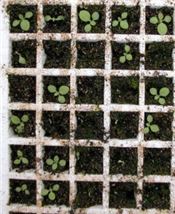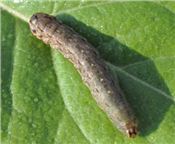Cutworms In Tobacco Float Beds
DR. LEE TOWNSEND
LEXINGTON, KY.
Variegated cutworms can cause significant damage to developing tobacco transplants (Figure 1). Infestations begin when the moths fly in early spring and enter greenhouses or get under float bed covers. A female lays clusters of about 60 eggs on surfaces ranging from stems or leaves of low-growing plants to walls or bed covers.
Newly hatched small caterpillars fan out in search of food, and it is hard to name something they will not eat. Since eggs are laid in masses, damage to float plants often occurs in distinct pockets on several adjacent trays near greenhouse doors or sides, or float bed margins. Cutworms typically feed at night or on overcast days and hide in the plant growth media during the day.
The smooth larvae can vary from pale gray to dark brown or black with a row of 4 to 7 pale spots in a line down the center of their backs (Figure 2). These cutworms feed for about 4 weeks; they are as much as 1½ inches long when full grown.
Management
Scan trays regularly for the first signs of empty cells that may indicate that cutworms are active. Look for notches in leaves as a sign of feeding. Orthene can be used as a foliar spray for control. Bt sprays can be effective against cutworms less than 1/2 inch long. Treat the area showing damage and a substantial border area around it. Watch for signs of continued feeding and for new areas of infestation. ∆
DR. LEE TOWNSEND: Extension Entomologist, University of Kentucky

Figure 1. Variegated cutworm damage may appear as empty cells, single stems, or notches chewed from leaf margins.
Photos: Lee Townsend, UK

Figure 2. Variegated cutworm – note the row of single light spots along its back.